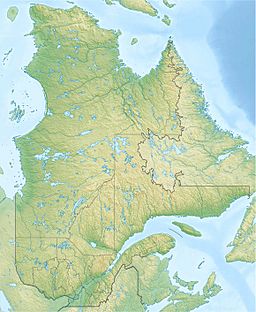Lac à Mars facts for kids
Quick facts for kids Lac à Mars |
|
|---|---|
| Location | Lac-Pikauba |
| Coordinates | 47°48′45″N 71°02′02″W / 47.8125°N 71.03389°W |
| Lake type | Natural |
| Primary inflows | Sept petits ruisseaux riverains dont la décharge du lac Moche. |
| Primary outflows | Rivière à Mars North-West |
| Basin countries | Canada |
| Max. length | 2.3 km (1.4 mi) |
| Max. width | 0.8 km (0.50 mi) |
| Surface elevation | 858 m (2,815 ft) |
Lac à Mars is a freshwater lake in the Canadian province of Quebec. It's part of a larger water system that flows into the Saguenay River. This lake is located in a wild area called Lac-Pikauba. This area is within the Charlevoix Regional County Municipality.
Lac à Mars is found in the central-eastern part of the Laurentides Wildlife Reserve. This reserve is a protected natural area. The main activities around the lake are forestry (managing forests for wood) and recreational tourism (like hiking or fishing).
The lake's surface usually freezes over in early December. It stays frozen until the end of March. You can generally walk or play safely on the ice from mid-December to mid-March.
Contents
Discovering Lac à Mars: Its Location and Features
The mouth of Lac à Mars is about 11.5 km (7.1 mi) northeast of the border between two administrative regions. These are Saguenay–Lac-Saint-Jean and Capitale-Nationale. Many rivers and lakes are close to Lac à Mars.
Nearby Rivers and Lakes
- To the north: Cyriac River, rivière à Mars North-West, rivière à Mars, rivière à Pierre, and Ruisseau au Goéland.
- To the east: rivière à Mars, Raymond Lake, Vents Lake, and Chemin des Canots River.
- To the south: Lac des Pas Perdus, Bouleaux Lake, Pas Perdus Lake, Grand Lac des Enfers, Philippe Stream, and Chicoutimi River.
- To the west: Pikauba Lake, Davis Lake, Fortier Lake, Claveau Brook, Noir Brook, and Apica River.
Size and Shape of Lac à Mars
Lac à Mars is about 2.3 km (1.4 mi) long. It has a unique shape, like a woman's head seen from the side. The lake is about 0.8 km (0.50 mi) wide at its widest point. Its elevation is 858 m (2,815 ft) above sea level. The lake's total area is .
There is a narrow bay on the east side that stretches for 0.17 km (0.11 mi). The southern part of the lake also narrows to 0.34 km (0.21 mi). A piece of land, called a peninsula, sticks out from the eastern shore. It's shaped like a hook and is about 0.15 km (0.093 mi) long. This peninsula makes the northern part of the lake narrower.
Where the Water Flows From Lac à Mars
The water from Lac à Mars flows out from a bay on its north shore. From there, the water travels a long way:
- First, it flows into the rivière à Mars North-West for about 26.6 km (16.5 mi) towards the north.
- Then, it joins the rivière à Mars and flows for about 66.0 km (41.0 mi) generally north.
- Next, it reaches the Baie des Ha! Ha! for about 11 km (6.8 mi) northeast.
- Finally, it enters the Saguenay River and travels about 99.5 km (61.8 mi) east to Tadoussac. At Tadoussac, the Saguenay River joins the large Saint Lawrence estuary.
The Story Behind the Name: Toponymy
Toponymy is the study of place names. The names "Rivière à Mars", "Rivière à Mars Nord-Ouest", and "Lac à Mars" all come from the same origin. The name "Lac à Mars" was officially recognized on December 5, 1968. This was done by the Commission de toponymie du Québec, which is a group that names places in Quebec.
Appendices
Related articles
- Charlevoix Regional County Municipality
- Lac-Pikauba, a TNO
- Rivière à Mars North-West
- Rivière à Mars
- Baie des Ha! Ha!
- Saguenay River


